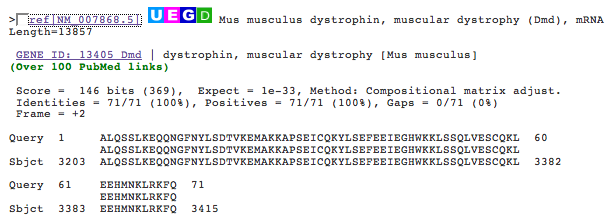
This page was produced as an assignment for an undergraduate course at Davidson College.
How to do blastx, tblastn, and tblastx
Now that you know how to do BLAST with a nucleotide sequence and an amino acid sequence as your query, getting to know the other programs should be easy. For blastx and tblastx, you enter a nucleotide sequence. The results for blastx and tblastx include the "Frame" result, which replaces "Strand" result of the nucleotide blast. "Frame" reports which nucleotide was the starting nucleotide for translation. This makes sense because you would get a very different amino acid sequence when starting at the first nucleotide on the positive strand of a sequence (the +1 frame) then when you started on the third nucleotide of the reverse complement strand of the sequence (the -3 strand). Because three nucleotides code for one amino acid, the frame result must be +1, +2, +3, -1, -2, or -3. In tblastx, because you are translating both the query and the subject sequence, the "Frame" result gives you two numbers.
With tblastn, you enter an amino acid sequence. One major difference between tblastn and protein blast is that the numbers flanking the subject sequence represent the nucleotide numbers in the gene you matched. For example, I performed a tblastn query with the same sequence we used in the last section (1 alqsslkeqq ngfnylsdtv kemakkapse icqkylsefe eieghwkkls sqlvescqkl eehmnklrkf) and the top match looked like this:

The number 3203 represents that the sequence my query matched is from nucleotide 3203-3415 in the dystrophin nucleotide sequence in mice. The "Frame = +2" means that the nucleotide sequence translated to my queried amino acid sequence when you start translating at the second nucleotide on the positive strand.
How to use BLAST Front Page
Genomics Page
Biology Home Page
Samantha's Home Page
Halorhabdus utahensis Genome Wiki